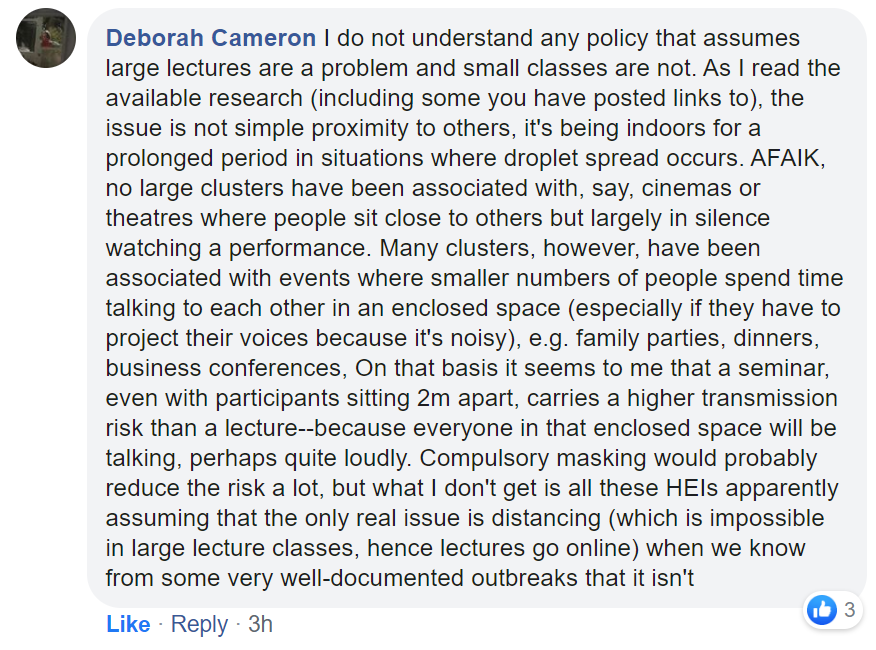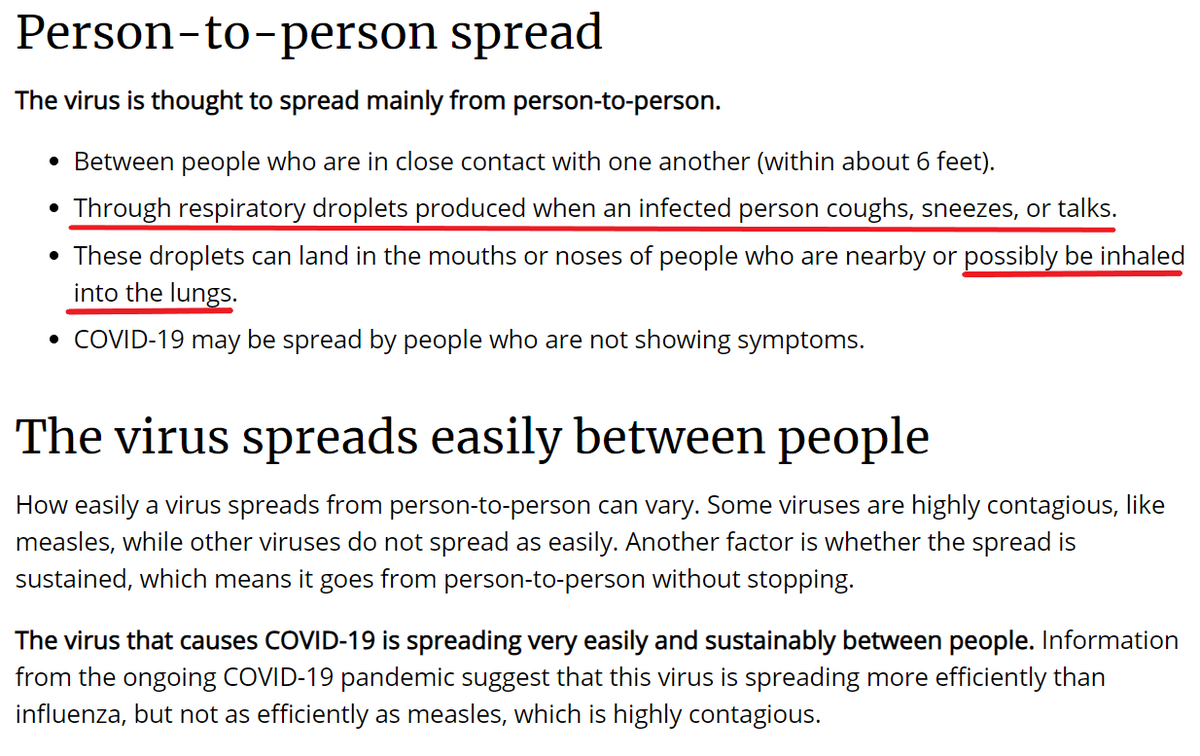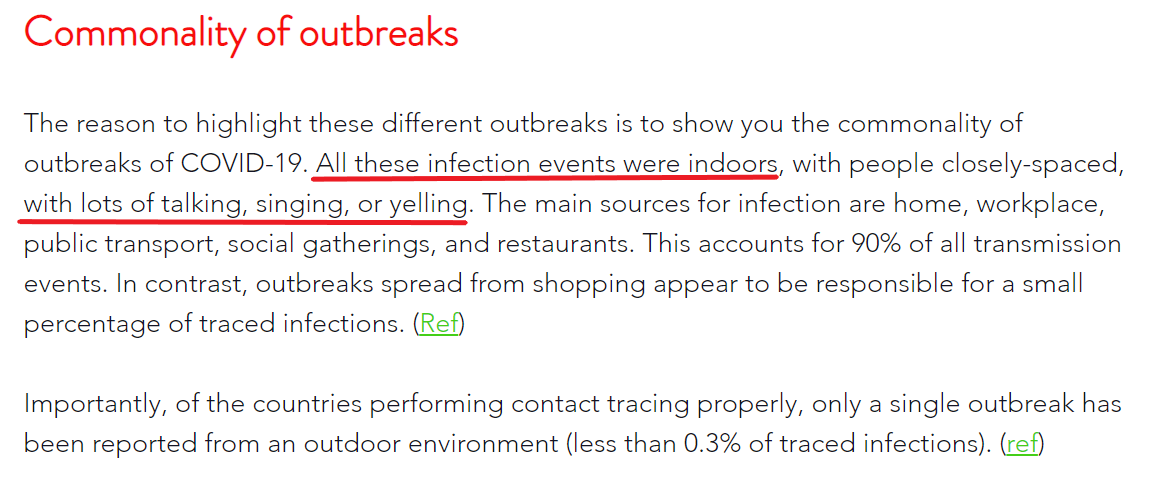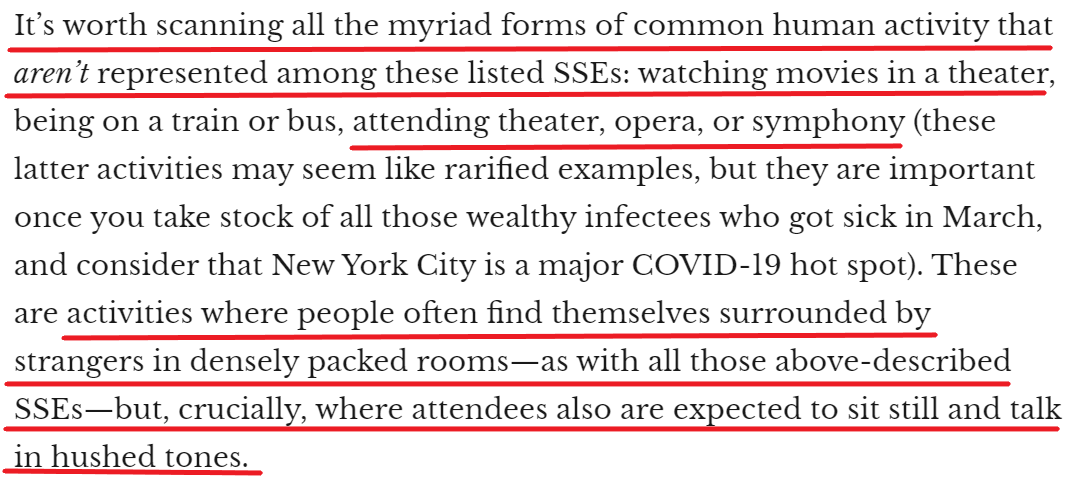
.@UniofOxford prof Deborah Cameron notes👇a key respect in which small group teaching is a greater Covid risk than large lectures, casting doubt on @Cambridge_Uni's moving large lectures online while keeping small group teaching in person. (@AlistairJarvis @michelledonelan) 1/ 

I'm devoting a single thread to her comments (originally posted on Facebook & reposted on Twitter with her permission), since I do not think their significance has yet fully registered with higher education, government & public health officials. 2/
To drive home their significance, I first draw attention to this👇passage in (linked) US @CDCgov guidance for higher education:
"COVID-19 is mostly spread by respiratory droplets released when people TALK, cough, or sneeze" (my emphasis). 3/
cdc.gov/coronavirus/20…
"COVID-19 is mostly spread by respiratory droplets released when people TALK, cough, or sneeze" (my emphasis). 3/
cdc.gov/coronavirus/20…

On the CDC's (linked) "How COVID-19 Spreads" webpage, talking is also listed alongside coughing and sneezing, in the second of four bullet-pointed means by which the virus "mainly" spreads👇. 4/
cdc.gov/coronavirus/20…
cdc.gov/coronavirus/20…

Why does the CDC group something as apparently innocuous as talking together with coughing & sneezing as a significant risk factor? 5/
Because of mounting evidence, via case studies (some w detailed CDC analysis), that talking (or singing) was the most likely means by which Covid-19 was spread from a single individual to many others indoors, more than 2 meters away, via inhalation into their lungs. 6/
See this linked analysis👇of case studies by @Erinbromage, a Comparative Immunologist and Professor of Biology. 7/
erinbromage.com/post/the-risks…
erinbromage.com/post/the-risks…

See also this survey of 58 case studies of "superspreader events" (SSE) by @jonkay, in which he draws attention to the dog that didn't bark👇. 8/
quillette.com/2020/04/23/cov…
quillette.com/2020/04/23/cov…

👆is of special relevance to this thread, since a large lecture, generally involving a single speaking individual, at some distance from the audience, is akin to @jonkay's red-underlined events that are absent from the list of SSEs. 9/
In addition to noting this fact in 1/👆, Deborah Cameron also draws attention to the respects in which small, participatory group teaching shares the risk factors of various catalogued SSEs. 10/
Why, then, are universities such as @Cambridge_Uni moving apparently less risky events online (large lectures), & trying to keep the apparently more risky events in person (small group teaching)? 11/
Here's one rationale (see linked @Cambridge_Uni statement 👇): even if they're not inherently very risky, cancelling large lectures will free up space to allow for small group teaching which conforms to govt guidelines of 2 metre social distancing. 12/
cam.ac.uk/coronavirus/ne…
cam.ac.uk/coronavirus/ne…

There is a problem with this proposed solution: when we're all spread out by 2 metres, we'll all need to speak more loudly to compensate for the larger distances. 13/
Moreover, "Highly sensitive laser light scattering observations have revealed that loud speech can emit thousands of oral fluid droplets per second". Please read entire quoted abstract👇of study, for relevance to small group teaching indoors. 14/
pnas.org/content/early/…
pnas.org/content/early/…

We also have mounting evidence that a single loudly speaking or singing individual can spread Covid-19 far more than 2 metres over time: e.g., throughout a restaurant, a volleyball-court-sized space, or the large floor of a call centre. See @erinbromage 👇. 15/ 

UK govt's current one-size-fits-all application of 2 metre social distancing to parks, garden centres, open plan offices, classrooms & public transport undermines their credibility. 2 metre social distancing is not some universal magic barrier. It doesn't work like this👇. 16/
.@Cambridge_Uni & others will need to go beyond current govt guidance to render classrooms safe for students & staff. See this thread for more on the risks of small group teaching 👇 & the measures (testing & face masks) necessary to mitigate them. 17/17
https://twitter.com/MikeOtsuka/status/1261591169844350983
Link to a thread about the sort of testing & tracing necessary to make universities safe... 1/
https://twitter.com/MikeOtsuka/status/1262826858376290307
...and how (in combination with adequate testing) the procurement & provision of proper faskmasks (e.g., PPF1 N90) might make it possible to safely resume small group in person teaching in the autumn. 2/
https://twitter.com/MikeOtsuka/status/1263357431373017088
Universities will need assistance from the government to deliver on testing & facemasks. See this thread on South Korea v the UK, regarding the good that a government can do, when it has got its act together. 3/3
https://twitter.com/MikeOtsuka/status/1263733951916580865
.@UniofOxford & @Cambridge_Uni tutors, please click here👇& read upward for a discussion of risks specific to the Oxbridge tutorial. (@OxfordUCU @CambridgeUCU)
https://twitter.com/MikeOtsuka/status/1264271185912750081
See Japan's guidance, in contrast to the UK's: "avoid the Three Cs: closed-in spaces [with insufficient ventilation], crowds, and conversations." 1/
https://twitter.com/TakuTamaki/status/1264278230153994241
Japan's population is nearly twice as large as the UK's & they're much closer to the Wuhan source of the pandemic. They've had about 16k total infections & are now recording about 80 new infections each day👇. 2/
endcoronavirus.org/countries?item…
endcoronavirus.org/countries?item…
By contrast, the UK has had about 240k total infections & are now recording about 3,500 new infections each day👇. Whom should we trust, in choosing between the conflicting Covid public health advice of these two countries? 3/3
endcoronavirus.org/countries?item…
endcoronavirus.org/countries?item…
Further evidence that being in the same small seminar room with an infected person for an extended period of time is more dangerous than being in the same large lecture theatre as that person: 1/
Linked👇study involving two buses that transported individuals to a Temple event. An infected person was on one of the two buses. 2/
researchgate.net/publication/34…
researchgate.net/publication/34…
This is what happened👇(quoting from linked Vox piece, whose author @B_resnick also interviews @mugecevik). 3/
vox.com/science-and-he…
vox.com/science-and-he…

So when one is in the same small space (e.g., bus, seminar room) as an infected person for an extended period of time, the chances of infection are much higher than if you share the same large space (e.g., temple, large lecture theatre). 4/
Note also that the absolute number (24) infected by this individual because they shared the same bus is much higher than the absolute number (7) infected by this individual because they were in the same temple (and whom the study describes as in close proximity). 5/
A plausible hypothesis is that the virus dispersed to a greater extent through the larger space of the temple, and hence others didn't breathe in as high a concentration. 6/6
I've added two new tweets to my @UniofOxford & @Cambridge_Uni tutors subthread. 1st new tweet👇. 1/ (@OxfordUCU @CambridgeUCU)
https://twitter.com/MikeOtsuka/status/1264289819636707339
Below are some words from @BoltonUni's VC in defence of their plans to re-open👇. If only small, enclosed, unventilated classrooms & seminar rooms were as easy to re-open as large, outdoor garden centres....
theboltonnews.co.uk/news/18467963.…
theboltonnews.co.uk/news/18467963.…

.@Penn has announced plans for in person teaching: only for classes w 25 or fewer, but with "facial coverings" & "could even include newly installed Plexiglas barriers for separating lecturers from the audience", in addition to physical distancing.
coronavirus.upenn.edu/announcement/m…
coronavirus.upenn.edu/announcement/m…

Excerpt👇from an article by @xtophercook, which is relevant to the theme of this thread. 1/ 

.@adamtickell & other VC's need to assure staff & students that they will not merely rely on what govt guidance allows -- that they will also provide us w the evidence that this is safe. 1/
ft.com/content/3cd114…
ft.com/content/3cd114…

Universities cannot repeat the mistake that some made in March of simply relying on govt guidance back then. 2/2
https://twitter.com/eeleach/status/1264460176133959683
UK govt's response to concerns regarding airborne Covid transmission in courtrooms is alarming👇. It indicates that they're ignoring an increasing body of evidence of such transmission, esp via speaking.
lawgazette.co.uk/news/dont-worr…
lawgazette.co.uk/news/dont-worr…

🚨🚨🚨This👇, published in Science yesterday, DIRECTLY contradicts UK govt claim👆of low risk of airborne Covid-19 transmission. Also calls for universal wearing of masks. @UniversitiesUK & @AlistairJarvis please take note of inadequacy of govt guidance.
science.sciencemag.org/content/early/…
science.sciencemag.org/content/early/…

This @NewYorker interview w Harvard prof of medicine & health care policy @Asaf_Bitton provides further evidence of how out of step w scientific & public health consensus the UK govt is on airborne transmission & masks.
newyorker.com/news/q-and-a/h…
newyorker.com/news/q-and-a/h…

• • •
Missing some Tweet in this thread? You can try to
force a refresh







